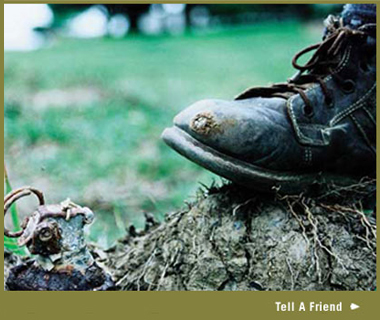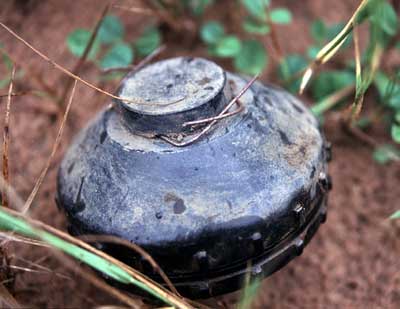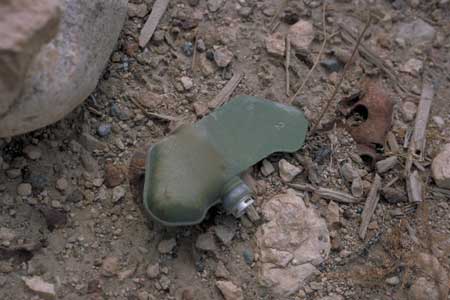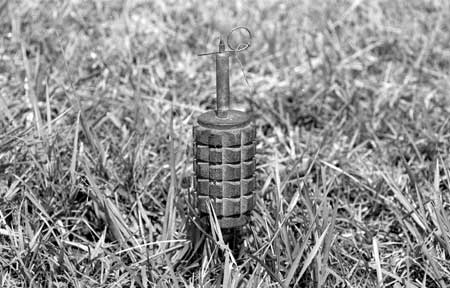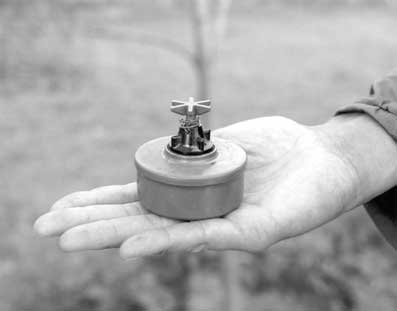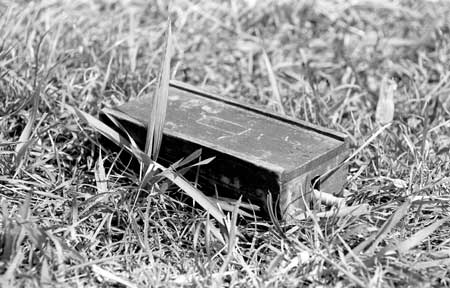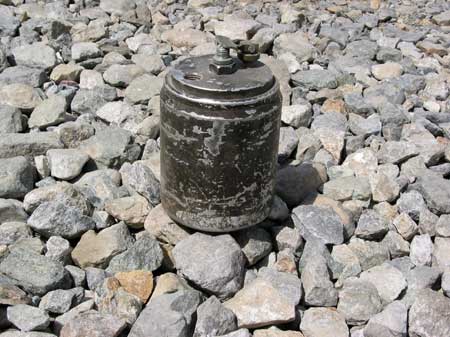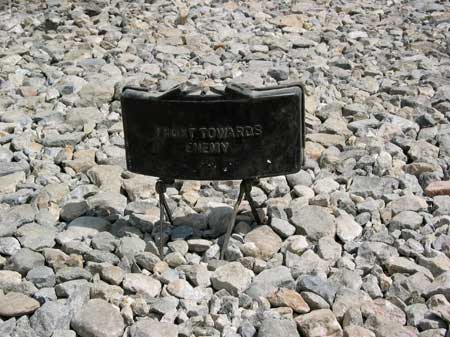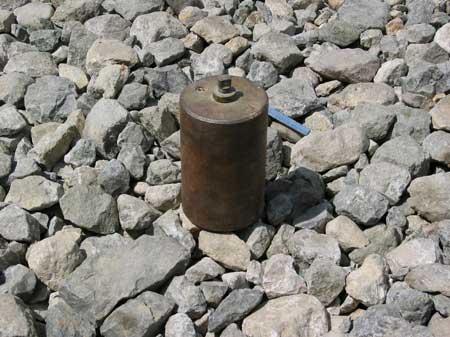THE LEGACY OF WAR
|
A DEADLY LEGACY
"I believe it is possible for ordinary people to achieve extraordinary things."—Jody Williams, 2006
In 1992, a coalition of organizations founded the International Campaign to Ban Landmines (ICBL) in response to growing evidence of the widespread use of landmines
and their deadly legacy. Over the next five years, the campaign raised international awareness of the proliferation of these weapons and their impact on the health
and livelihoods of civilians. As a result, 122 nations signed an international treaty agreeing to ban the stockpiling and use of landmines. In 1997, ICBL was awarded
the Nobel Peace Prize.
1997 Convention on the Prohibition of the Use, Stockpiling, Production, and Transfer or Anti-Personnel Mines and on Their Destruction (Mine Ban Treaty)
The treaty was signed by 122 countries in December 1997 in Ottawa, Canada, and became binding under international law in March 1999. Countries that did not join before
this date can sign on at any time. The full list is available online at the ICBL web site: http://www.icbl.org/treaty
A landmine in Colombia, 2003 Courtesy UNICEF-BAO/Luz Piedad Herrerar
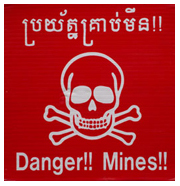 Sign warning of landmines in the area, Cambodia, 1992
Sign warning of landmines in the area, Cambodia, 1992
Courtesy Physicians for Human Rights
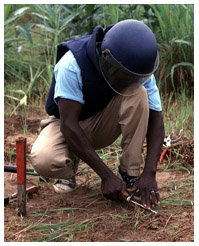 Removing a landmine, Angola, 1997
Removing a landmine, Angola, 1997
Courtesy Tim Grant
Landmines dispersed during conflicts can take years to be cleared after the end of hostilities. The International Campaign to Ban
Landmines lobbies to ban the use, stockpiling, production, and transfer of landmines, supports people injured by them, and works to increase resources for
mine clearance.
 Prosthetic legs fitted with shoes belonging to their owners, Angola, 1997
Prosthetic legs fitted with shoes belonging to their owners, Angola, 1997
Courtesy Tim Grant
The majority of people killed or injured by landmines are young civilians aged between twenty and thirty-five. Because these weapons
are designed to cause severe wounds, survivors need emergency health care and are often permanently disabled.
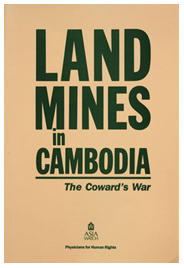 Landmines in Cambodia: The Coward's War, 1991
Landmines in Cambodia: The Coward's War, 1991
Courtesy National Library of Medicine
In 1991, Physicians for Human Rights (PHR) and Asia Watch (now Human Rights Watch/Asia) reported on the legacy of landmines in Landmines in Cambodia: The Coward's War. PHR joined with five other organizations to launch the International Campaign to Ban Landmines in response to the
report—Handicap International from France, Medico International from Germany, the Mines Advisory Group from the United Kingdom, and Human Rights Watch and
the Vietnam Veterans of America Foundation from the United States. Today, ICBL is a network of more than fourteen hundred groups in ninety countries.
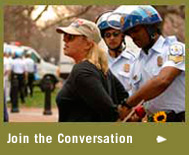 Jody Williams demonstrating against war, Washington, DC, 2003
Jody Williams demonstrating against war, Washington, DC, 2003
Courtesy Linda Panetta, Optical Realities Photography
Jody Williams coordinated the International Campaign to Ban Landmines. She has participated in events all over the world to protest
landmines and has risked arrest to express her opposition to war.
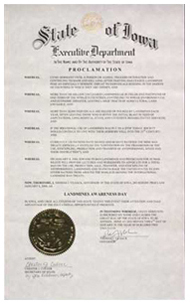 Landmine Awareness Day proclamation, Iowa, 2000
Landmine Awareness Day proclamation, Iowa, 2000
Courtesy Physicians for Human Rights
In America, individual states have declared Landmine Awareness Days in support of the work of the International Campaign to Ban Landmines.
Physicians for Human Rights, part of the United States Campaign to Ban Landmines, holds workshops and presents lectures to encourage the government to sign the Mine
Ban Treaty.
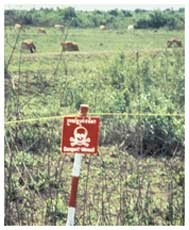 Farmland blighted by landmines, Cambodia, 1992
Farmland blighted by landmines, Cambodia, 1992
Courtesy Preston Reynolds, M.D., Ph.D., photograph by Eric Stover
As well as causing injuries that may prevent survivors from working, landmines ruin agricultural land, compounding poverty and
hunger in rural communities. People injured in these areas live far from city hospitals and have limited access to the treatment they need to survive or
save their limbs.
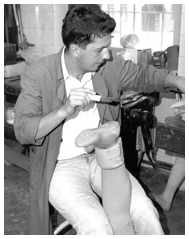 A technician making a prosthetic leg for a landmine survivor, Bosnia, 1996
A technician making a prosthetic leg for a landmine survivor, Bosnia, 1996
Courtesy International Campaign to Ban Landmines/John Rodsted
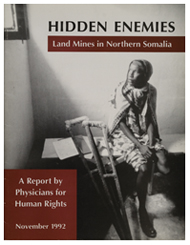 Hidden Enemies: Landmines in Northern Somalia, 1992
Hidden Enemies: Landmines in Northern Somalia, 1992
Courtesy Physicians for Human Rights
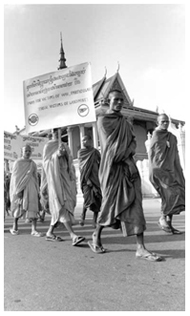 Buddhist monks protesting against landmines, Cambodia 1996
Buddhist monks protesting against landmines, Cambodia 1996
Courtesy International Campaign to Ban Landmines/John Rodsted
Cambodia was heavily contaminated by landmines during nearly three decades of conflict, beginning with the Vietnam War. In 1997, the country became
one of the first group of nations to sign on to the Mine Ban Treaty.
 Pyramid of shoes symbolizing the impact of landmines, Paris, 1997
Pyramid of shoes symbolizing the impact of landmines, Paris, 1997
International Campaign to Ban Landmines/John Rodsted
In 1997, in cooperation with the International Campaign to Ban Landmines (ICBL), world leaders began to plan a comprehensive
international treaty. ICBL held events displaying symbols of the damage done by these weapons and asking leaders to pledge their support. By the end of the
year, ninety-seven nations had endorsed a declaration committing to a treaty.
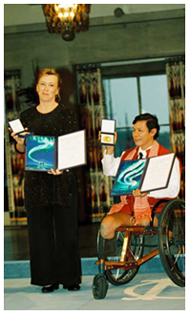 ICBL ambassadors Jody Williams and Tun Channereth, Nobel Peace Prize Ceremony, Oslo, Norway, 1997
ICBL ambassadors Jody Williams and Tun Channereth, Nobel Peace Prize Ceremony, Oslo, Norway, 1997
Courtesy Arne Knudsen/Knudsen Fotosenter
In December 1997, 122 nations signed an international treaty banning the production, use, and stockpiling of landmines. A week later, members of the ICBL
and the founding coordinator of the campaign, Jody Williams, were awarded the Nobel Peace Prize for their work.
Next
 Jody Williams demonstrating against war, Washington, DC, 2003
Jody Williams demonstrating against war, Washington, DC, 2003 Farmland blighted by landmines, Cambodia, 1992
Farmland blighted by landmines, Cambodia, 1992 Buddhist monks protesting against landmines, Cambodia 1996
Buddhist monks protesting against landmines, Cambodia 1996 Pyramid of shoes symbolizing the impact of landmines, Paris, 1997
Pyramid of shoes symbolizing the impact of landmines, Paris, 1997 ICBL ambassadors Jody Williams and Tun Channereth, Nobel Peace Prize Ceremony, Oslo, Norway, 1997
ICBL ambassadors Jody Williams and Tun Channereth, Nobel Peace Prize Ceremony, Oslo, Norway, 1997